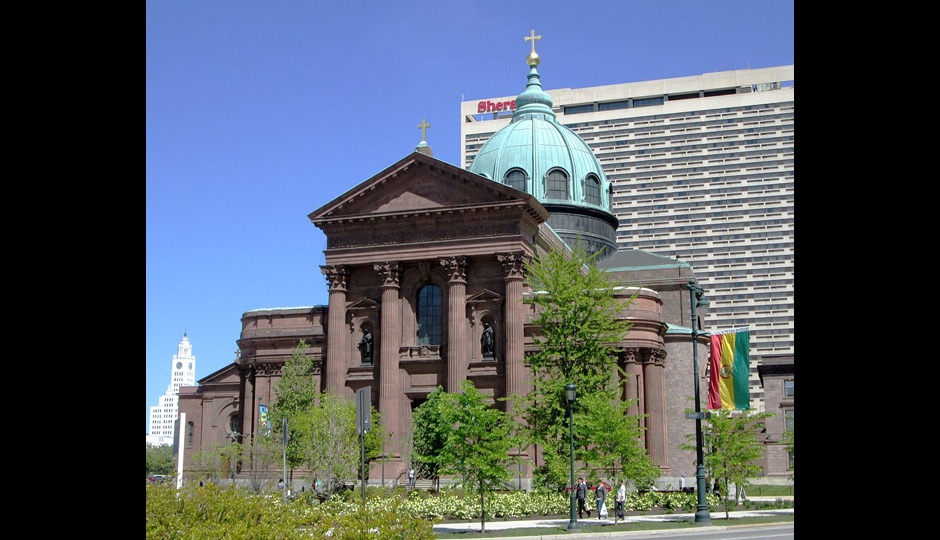Philly’s Archdiocese Needs to Rip Off the Band-Aid

Cathedral Basilica of Saints Peter and Paul. Photo Beyond My Ken.
Every morning, I pass the entrance of St. Laurentius elementary school on Berks Street in Fishtown. “Have a great day, hon!” shouts the principal, who stands outside with two teachers every morning — including every single day of the Polar Vortex — to safely usher her students into the building. Even on the rainiest, grayest days, this part of my commute always makes me smile.
Seeing the plaid-wearing students — their backpacks bigger than their little backs and their stretched-out knee socks flapping around their ankles — run into their elementary school resonates with me deeply. Though I no longer identify as a member of the Church, I know that my 12 years of religious education and worship shaped the way Iive my life now — and not just in my deep appreciation for punctuality and knee-length skirts. I believe in the community that can come from being a member of a parish and how a church — and especially, a school — can anchor a neighborhood and help it weather tough times.
Those of us who grew up in the culture of Philadelphia parochial schools, are bound by them even now. When I chat with childhood friends, we don’t refer to neighborhoods, we refer to parishes. “She went to Cecilia’s,” we’ll say. Or “He moved from St. William’s to St. Al’s,” we’ll explain with a knowing look. (This helps us avoid saying what we really mean: that relocating from Lawncrest to Huntingdon Valley means someone is movin’ on up in the world.)
There was a time when the Archdiocese was brimming with so many devout Catholics that a community, like my current one in Fishtown, could support two churches and schools within three blocks of each other. If I walk out my door and turn left, I am at St. Laurentius Church. If I turn right, I am at Holy Name of Jesus. At one point, both of these churches and schools were full and functional. This is not the reality of the Catholic Church in Philadelphia anymore.
Now, St. Laurentius has a school but no church and Holy Name has a church but no school.
This week, when word came down from the almighty Archdiocese that 16 parishes are closing their doors, I understood exactly the kind of heartbreak the parishioners of those churches were feeling. When my alma mater, Cardinal Dougherty High School, closed a few years ago, I watched with great interest as alumni threw rallies and raised money in hopes of buying just one more year. I followed the Facebook posts and online message boards. The day we knew the school’s fate was sealed, I felt a strange sadness in knowing that no one else would attend my school. The same feeling returned the next year, when St. William’s elementary school — my elementary alma mater and once one of the largest parochial schools in Philadelphia — was shuttered.
I’m not alone. Every year, it’s someone else’s church, someone else’s parish. The Archdiocese of Philadelphia is, like many archdioceses across the country, struggling to survive. Every year, congregations all over the region send up their prayers and light their vigil candles, hoping to save their churches.
The anguish has to stop.
My suggestion to the Archdiocese: Put these people out of their misery already.
Instead of doing it piecemeal over the course of years, speed up the foregone conclusion. Don’t close a few schools and churches each year, do one big shutdown. Get smart, impartial people to look at the data on each parish. Don’t make decisions based on internal politics or emotional connections. Choose the buildings that are the most economically efficient to maintain in the long-run. Keep just one school and one church open in each neighborhood. Funnel resources — from clergy and educators to dollars and cents — into bettering each community’s school and place of worship.
Yes, this is an extreme solution. And yes, the parishioners of the closed churches would be forced to relocate their worship. For those who truly have faith, those who truly want to attend Mass and give their children parochial education, they will make it work. They will acclimate to a new church and a new school and they will begin to rebuild the Catholic community in their neighborhood. It won’t be easy and it won’t come quickly, but it can happen — and it will ultimately be less painful than worrying each year that this is the final one for a church. But in the words of someone wiser than me, “It is better to know and be disappointed, than to not know and always wonder.”
This morning, when I walked past St. Laurentius, I saw the kids in their shirtsleeves running into their school on one of the last days of the academic year. I remembered the young excitement of being on the cusp of a gloriously long summer vacation. Back then, it never occurred to me that one day my schools and my church might not be around when I grew up. I wonder: Could these kids possibly understand that?
Follow @errrica on Twitter.


